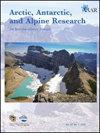瑞典北部Veiki冰碛的MIS 3年龄-测定斯堪的纳维亚半岛一个中等大小冰盖的地形记录的年代
IF 2
4区 地球科学
Q4 ENVIRONMENTAL SCIENCES
引用次数: 3
摘要
瑞典北部的Veiki冰碛是一个地貌独特的冰壁湖平原景观,被解释为代表中等规模的末次极大冰期(LGM)芬诺斯坎德冰盖的前边缘,但其年龄在海洋同位素阶段(MIS) 5c或MIS 3之间存在争议。我们利用光激发发光(OSL)和放射性碳测年技术对Veiki冰碛北部的四个地点进行了测年,以确定其年代。放射性碳年龄只能提供最小年龄,由于发光特性差和不完全漂白问题,大多数OSL年龄精度低,导致两个替代年龄。在这两种情况下,OSL定年将Veiki冰碛地层置于MIS 3(最佳估计为56-39 ka)。在MIS 3和全新世期间,沉积在一些高原(冰壁湖平原)的低洼中心继续进行,在末次盛冰期期间,该地区被冰覆盖。我们推测,通过将事件序列与其他气候记录联系起来,进一步限制了广泛的时间。我们认为,在格陵兰间冰期(GI) 16.1 (58.0 ~ 56.5 ka)期间,Veiki地区西部的冰缘发生了退缩,而在随后的GS-16.1 ~ 15.1 (56.5 ~ 54.2 ka)期间,Veiki地区的冰缘发生了有限的推进,导致了碎屑覆盖的冰缘。GI-14期开始于54.2 ka,持续~5.9 ka,可能是死冰景观中冰融化的时期,首先形成了冰壁湖,后来形成了魏其景观的逆地形特征。本文章由计算机程序翻译,如有差异,请以英文原文为准。
MIS 3 age of the Veiki moraine in N Sweden – Dating the landform record of an intermediate-sized ice sheet in Scandinavia
ABSTRACT The Veiki moraine in northern Sweden, a geomorphologically distinct landscape of ice-walled lake plains, has been interpreted to represent the former margin of an intermediate-sized pre–Last Glacial Maximum (LGM) Fennoscandian ice sheet, but its age is debated as either marine isotope stage (MIS) 5c or MIS 3. We have applied optically stimulated luminescence (OSL) and radiocarbon dating to four sites within the northern part of the Veiki moraine to establish its chronology. The radiocarbon ages provide only minimum ages and most OSL ages have low precision due to poor luminescence characteristics and problems with incomplete bleaching, leading to two alternative ages. In either case, the OSL dating places the Veiki moraine formation in MIS 3 (best estimate 56–39 ka). Sedimentation continued in the low-lying centers of some plateaus (ice-walled lake plains) during MIS 3 and during the Holocene, with a break during the Last Glacial Maximum when the area was ice covered. We speculatively constrain the broad timing further by relating the sequence of events to other climate records. We suggest that ice margin retreat to the west of the Veiki area took place during Greenland Interstadial (GI) 16.1 (58.0–56.5 ka) and that limited ice advances, which led to debris-covered ice margins in the Veiki zone, occurred during the following stadials GS-16.1 to 15.1 (56.5–54.2 ka). The GI-14 interstadial, which began 54.2 ka and lasted ~5.9 ka, could then be the period when the ice within the dead-ice landscape melted, first leading to ice-walled lakes and later to the inversed topography characteristic of the Veiki landscape.
求助全文
通过发布文献求助,成功后即可免费获取论文全文。
去求助
来源期刊
CiteScore
3.00
自引率
5.00%
发文量
37
审稿时长
7 months
期刊介绍:
The mission of Arctic, Antarctic, and Alpine Research (AAAR) is to advance understanding of cold region environments by publishing original scientific research from past, present and future high-latitude and mountain regions. Rapid environmental change occurring in cold regions today highlights the global importance of this research. AAAR publishes peer-reviewed interdisciplinary papers including original research papers, short communications and review articles. Many of these papers synthesize a variety of disciplines including ecology, climatology, geomorphology, glaciology, hydrology, paleoceanography, biogeochemistry, and social science. Papers may be uni- or multidisciplinary but should have interdisciplinary appeal. Special thematic issues and proceedings are encouraged. The journal receives contributions from a diverse group of international authors from academia, government agencies, and land managers. In addition the journal publishes opinion pieces, book reviews and in memoria. AAAR is associated with the Institute of Arctic and Alpine Research (INSTAAR) the oldest active research institute at the University of Colorado Boulder.

 求助内容:
求助内容: 应助结果提醒方式:
应助结果提醒方式:


